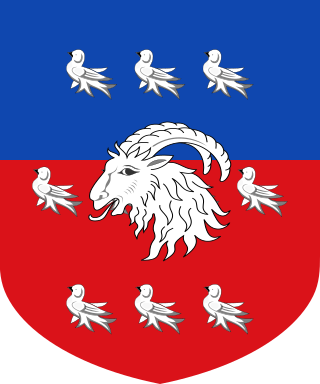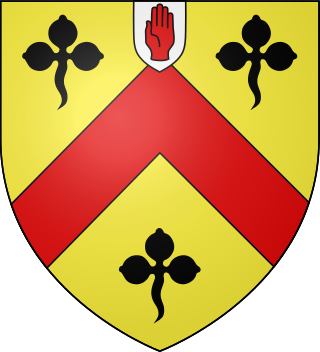
The Anson baronetcy, of Birch Hall in the County Palatine of Lancaster, is a title in the Baronetage of the United Kingdom held by a branch of the Anson family. It was created on 30 September 1831 for William Anson. He was the third son of George Anson; his elder brothers were Thomas Anson, 1st Viscount Anson, and General Sir George Anson. Sir William was the uncle of Thomas Anson, 1st Earl of Lichfield, and Major-General George Anson and the great-nephew of George Anson, 1st Baron Anson. His grandson, the third Baronet, was a lawyer and Liberal Unionist politician. He never married and was succeeded by his nephew, the fourth Baronet. He was the only son of Frederick Arthur Anson, third son of the second Baronet. The fourth baronet drowned in the Thames on an outing of The Coterie in July 1914, after he jumped into the river encouraged by lady Diana Manners. He had not married and on his death the title passed to his first cousin, the fifth Baronet, the eldest son of Rear-Admiral Algernon Horatio Anson (1854–1913), fourth and youngest son of the second Baronet. He was killed in action in the First World War. He was unmarried and was succeeded by his younger brother, the sixth Baronet. His elder son, the seventh baronet, was a Rear-Admiral in the Royal Navy. As of 2021 the title is held by the latter's son, the eighth Baronet, who succeeded in 2018.

The Ainsworth Baronetcy, of Ardnanaiseig in the County of Argyll, is a title in the Baronetage of the United Kingdom. It was created on 12 January 1917 for the industrialist, banker and Liberal politician John Ainsworth.

The Bagge Baronetcy, of Stradsett Hall in the County of Norfolk, is a title in the Baronetage of the United Kingdom. It was created on 13 April 1867 for William Bagge, Conservative Member of Parliament for West Norfolk. The sixth Baronet was Chairman of the West Norfolk District Council between 1976 and 1977.

There have been two baronetcies created for members of the Whitmore family, one in the Baronetage of England and one in the Baronetage of the United Kingdom. One creation is extinct while the other is extant.

The McLintock Baronetcy, of Sanquhar in the County of Dumfries, is a title in the Baronetage of the United Kingdom. It was created on 19 January 1934 for the accountant William McLintock. He was a senior partner in the firm of Thomson McLintock & Company, chartered accountants.

The Chance Baronetcy, of Grand Avenue in the parish of Hove in the County of Sussex, is a title in the Baronetage of the United Kingdom. It was created on 19 June 1900 for James Timmins Chance, a grandson of William Chance one of the Chance brothers who started the family business in 1771. He became head of Chance Brothers and Company. He was High Sheriff of Staffordshire in 1868.

The Kimber Baronetcy, of Lansdowne Lodge in Wandsworth in the County of London, is a title in the Baronetage of the United Kingdom. It was created on 24 August 1904 for Henry Kimber. He was the founder of the legal firm of Kimber and Ellis and also sat as Conservative Member of Parliament for Wandsworth between 1885 and 1913.

The Boord Baronetcy, of Wakehurst Place in the County of Sussex, is a title in the Baronetage of the United Kingdom. It was created on 18 February 1896 for the Conservative politician Thomas Boord. His eldest son, the second Baronet, died unmarried in 1928 and was succeeded by his nephew, the third Baronet. He was the son of Alexander Edgar Boord, third son of the first Baronet. The third Baronet's eldest son, the fourth Baronet, succeeded in 1975. On his death in 2019, the title passed to his nephew Andrew, an Istanbul-based translator and business development consultant.

The Lowe Baronetcy, of Edgbaston in the City of Birmingham, is a title in the Baronetage of the United Kingdom. It was created on 30 January 1918 for Francis Lowe, Conservative Member of Parliament for Edgbaston from 1898 to 1929.
The Lea Baronetcy, of The Larches in Kidderminster in the County of Worcester and Sea Grove in Dawlish in the County of Devon, is a title in the Baronetage of the United Kingdom. It was created on 6 October 1892 for Thomas Lea, Member of Parliament for Kidderminster, County Donegal and South Londonderry. The family descends from William Butcher, who in 1792 married Elizabeth, daughter of Francis Lea. Their son George Butcher assumed by Royal licence the surname of Lea in lieu of his patronymic in 1834. His son was the first Baronet.

The Maclure Baronetcy, of The Home in Whalley Range near Manchester in the County Palatine of Lancaster, is a title in the Baronetage of the United Kingdom. It was created on 12 March 1898 for John William Maclure. He was Secretary of the Famine Relief Fund from 1862 to 1865 and sat as Conservative Member of Parliament for Stretford between 1886 and 1901.

The Peek Baronetcy, of Rousdon in the County of Devon, is a title in the Baronetage of the United Kingdom. It was created on 13 May 1874 for Henry Peek. He was an importer of spices, tea and other groceries, a philanthropist and Conservative Member of Parliament for Surrey Mid. The second Baronet was an astronomer and meteorologist; the third Baronet was high sheriff of Devon in 1912.

The Payne, later Payne-Gallwey, and from 1967 Frankland-Payne-Gallwey Baronetcy, was a title in the Baronetage of the United Kingdom. It was created on 8 December 1812 for General William Payne, Governor of the Leeward Islands. Payne-Gallwey was the half-brother of Ralph Payne, 1st Baron Lavington, who also served as Governor of the Leeward Islands.

The Fletcher, later Boughey Baronetcy, of Newcastle-under-Lyme and of Betley both in the County of Stafford, is a title in the Baronetage of Great Britain. It was created on 24 August 1798 for Thomas Fletcher, of Betley Court, Staffordshire, High Sheriff of Staffordshire in 1783 and 1789 and Deputy Lieutenant of the county. He was the husband of Elizabeth Fenton, granddaughter of George Boughey, of Audley, Staffordshire whose will provided for his great-grandson to inherit the Audley estate.

The Milman Baronetcy, of Levaton-in-Woodland in the County of Devon, is a title in the Baronetage of Great Britain. It was created on 28 November 1800 for Francis Milman, Physician-in-Ordinary to King George III and President of the Royal College of Physicians. The seventh Baronet was a brigadier-general in the British Army.

The Smith, later Smith-Marriott Baronetcy, of Sydling St Nicholas in the County of Dorset, is a title in the Baronetage of Great Britain. It was created on 1 June 1774 for John Smith, High Sheriff of Dorset in 1772. The second Baronet married Elizabeth Anne, daughter of Reverend James Marriott. The fourth Baronet assumed by Royal sign-manual the additional surname of Marriott. The fifth Baronet was High Sheriff of Dorset in 1873.

The Fleming, later le Fleming Baronetcy, of Rydal in the County of Westmorland, is a title in the Baronetage of England. It was created on 4 October 1705 for William Fleming, Member of Parliament for Westmorland. The second Baronet was Bishop of Carlisle. The third Baronet represented Cumberland in the British House of Commons. The fourth Baronet was Member of Parliament for Westmorland. He assumed the surname of le Fleming, an ancient version of the family surname. This version of the surname has also been borne by the Baronets from the seventh Baronet onwards. The sixth Baronet, an ordained priest, served as Rector of Windermere.
The Hampson Baronetcy, of Taplow in the County of Buckingham, was a title in the Baronetage of England. It was created by King Charles I on 3 June 1642 for Thomas Hampson, second son of Sir Robert Hampson (1537-1607) one of the two Sheriffs of the City of London in 1599, knighted by King James I in 1603. The third Baronet sat as Member of Parliament for Chipping Wycombe in 1685. The tenth Baronet was an entomologist. The title became extinct on the death of the twelfth Baronet in 1969.

The Abdy Baronetcy, of Albyns, in the County of Essex, was created in the Baronetage of the United Kingdom on 22 December 1849 for Thomas Neville Abdy who sat for Lyme Regis in the British House of Commons. It was a second creation for the seat: see Abdy baronets of Albyns (1660).
The Sullivan baronetcy, of Thames Ditton in the County of Surrey, was created in the Baronetage of the United Kingdom on 22 May 1804 for the writer and MP Richard Sullivan. The third and sixth Baronets were Admirals in the Royal Navy. The ninth holder of the baronetcy did not use his title; as of 2023 the Official Roll marked the baronetcy as vacant.